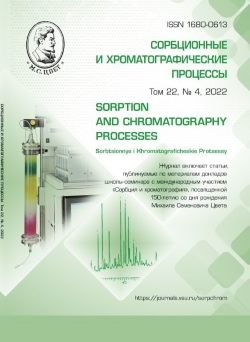Studying the sorption behaviour of 90Sr and 137Cs radionuclides in a soil-absorbing complex
Abstract
The article presents a study of the sorption of 137Cs and 90Sr radionuclides on soils of a natural forest ecosystem and soils modified by agricultural activities. It demonstrates the effect of the granulometric and mineralogical composition of soils, as well as the cation exchange capacity and the concentration of humic substances on the sorption and desorption of radionuclides.
The distribution coefficient of 137Cs for all the studied soils is n·104 cm3/g, which is at least an order of magnitude higher than the distribution coefficient of 90Sr. This is accounted for by the presence of a large amounts of clay minerals in all types of soils. Increased concentrations of humic substances in soils increase their sorption capacity towards caesium radionuclides and make the sorption process irreversible. Lower distribution coefficients of strontium for all types of soils indicate its greater migration ability, while the irreversibility of sorption is determined mainly by the mineral composition of soils.
In a situation of contamination with radionuclides, soils can act as a geochemical barrier preventing the migration of caesium to deeper layers both when radioactive contamination is a result of precipitation and when radionuclides are transported by pure soil solutions. When soils are contaminated with strontium, it will actively migrate to deeper soil layers, which will result in the purification of the fertile surface layers.
The article substantiates the activities aimed at rehabilitation of contaminated territories. Namely, it is possible to retain caesium and strontium in the upper soil layers by introducing sorption materials with a high sorption capacity. It is also possible to subject contaminated soil layers to treatment with substances which can compete with strontium in the sorption process.
Downloads
References
Sanzharova N.I., Geshel I.V., Krylenkin D.V., Gordienko E.V. Modern state of research on behavior of 90Sr in a ‘soil – agricultural plants’ system (a review). Radiation biology. Radioecology. 2019; 59(6): 643-655.
Sanzharova N.I., Geshel I.V., Mi-kailova R.A., Krylenkin D.V., Gordienko E.V. Remediation of agricultural lands contaminated by 90Sr. Remediation measures for radioactively contaminated areas (eds. Gupta D.K., Voronina A.). 2018: 139-162.
Nakamaru Y., Ishikawa N., Tagami K., Uchida S. Role of soil organic matter in the mobility of radiocesium in agricultural soils common in Japan. Coll. Surf. A. 2007; 306: 111-117.
Odintsov A.A., Sazhenyuk A.D., Satsyuk V.A. Association of 90xSr, 137Cs, 239,240Pu, 241Am, and 244Cm with Soil Absorbing Complex in Soils Typical of the Vicinity of the Chernobyl NPP. Radiochemistry. 2004; 46(1): 95-101.
Gilyarov M.S. Methods of soil-zoological research. M. Nauka Publ., 1975. 280 p.
Voronina A.V., Kutergin A.S., Se-menishchev V.S., Nogovitsyna E.V., Nikiforov A.F. Sorbents for radiocaesium removal from natural water and soil. Impact of Cesium on Plants and the Environment (Editors: D. K. Gupta, C. Walther) Springer. 2017: 231-252.
Voronina A.V., Blinova M.O., Semenishchev V.S., Gupta D.K. Sorption methods in rehabilitation of radioactively contaminated lands using surface-modified sorbents based on natural aluminosilicates. Remediation Measures for Radioactively Contaminated Areas. (eds. Gupta D.K., Voronina A.) 2018: 51-64.







